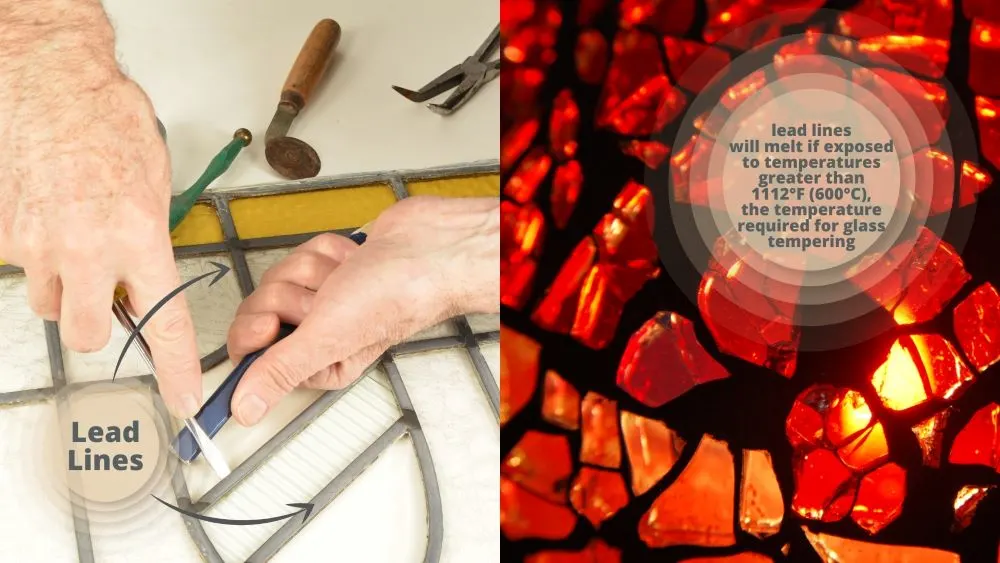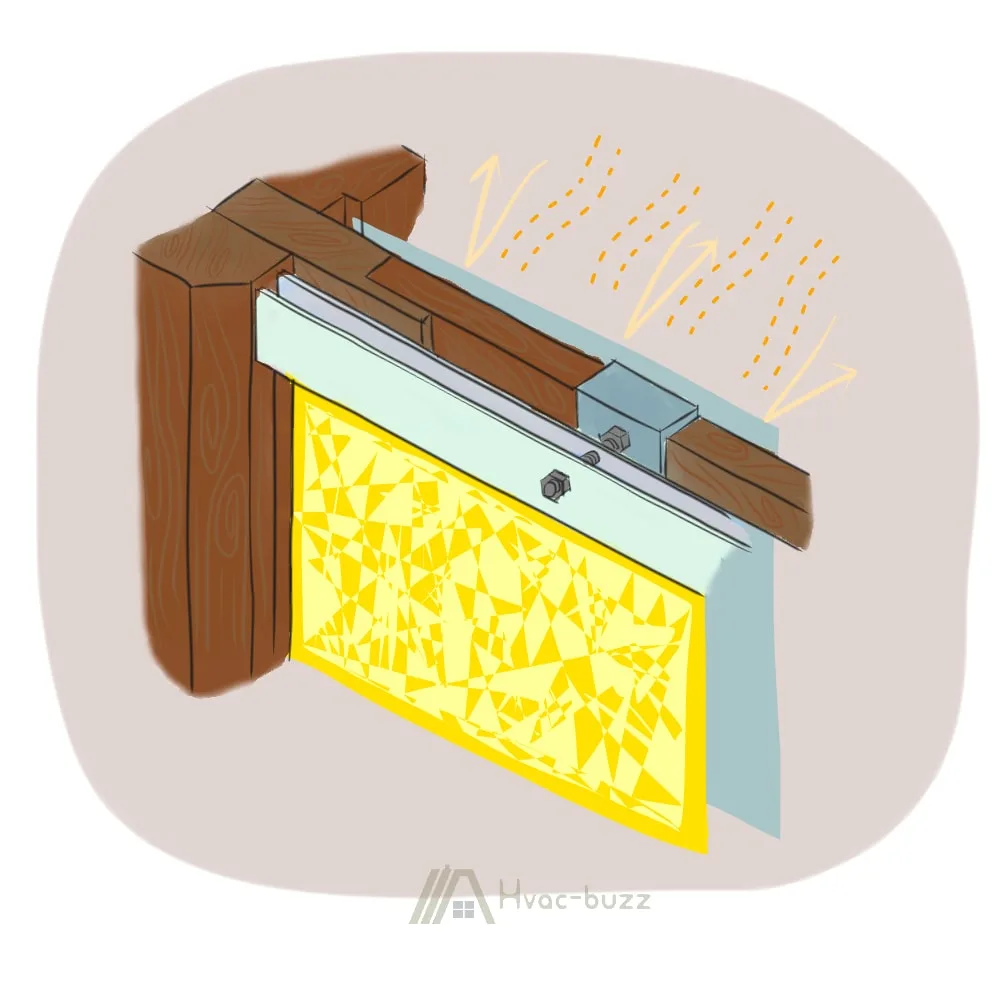Tempered glass is more robust, crack-resistant, and withstands thermal shock better than annealed glass, making it perfect for situations in which glass is subjected to extreme forces and human safety is a concern. It’s natural to wonder whether stained glass items can be made safer through tempering.
Historical artforms and modern processes do not often blend harmoniously with one another. While stained glass windows do not lend themselves to successful tempering, there are alternative pathways in which the artistry of stained glass is successfully combined with the safety features of tempered glass.

Stained glass cannot be tempered. Only homogenous glass windows can be safely tempered. Stained glass is a heterogeneous mixture of metal oxides and glass. Genuine stained glass windows are protected by double glazing with tempered glass. Faux stained glass windows can be tempered prior to painting.
How Is Glass Tempered?
Tempering may be performed in one of two ways. The first is through the use of tempering ovens and quenching, and the second is through the use of chemicals. The first method is preferred to chemical tempering, as chemical tempering is more expensive without the benefit of producing a significantly better product.
The sheet of glass is cleaned and inspected for any cracks or imperfections. Glass containing flaws cannot be tempered as the rapid expansion and contraction associated with tempering causes catastrophic failure at the flaw’s origin site.
Sharp edges are sanded and beveled (rounded or curved) to a smooth finish. The glass sheet is then placed in an oven and heated to 1112°F (600°C). The industry standard for heat treatment is 1148°F (620°C).
Once heated, the glass is quickly removed and quenched: high-pressure air is blown onto the surface of the glass, causing the glass to cool rapidly.
The difference between the hot interior and cool outer surfaces causes the interior molecules to “pull” away from the exterior surfaces, causing molecular compression on the surfaces and molecular tension along the internal planes of the glass.
Annealed glass or glass under tension shatters five times more easily than compressed glass!
Can You Temper an Existing Stained Glass Window?
To successfully temper glass, the glass pane needs to be chemically and structurally homogenous.
The Issue of Lead Lines
Authentic stained glass windows form mosaic patterns in which individual glass panes are joined together by soldered lead or copper strips, known as lead lines.
These lead lines are integral to the artistic experience of stained glass windows but will emit toxic fumes if heated (such as during the tempering process).

Copper’s melting point is 1984°F (1084°C), and lead’s is 621.5°F (328°C). The lead lines will melt if exposed to temperatures greater than 1112°F (600°C), the temperature required for glass tempering. Although the copper lines will not melt, they will soften and superheat the glass pane border, causing stress cracks to appear.
Genuine Stained Glass is Not Heterogenous
Stained glass is created by mixing microscopic, colored metal oxide particles, also known as metal salts, into molten glass. The metal oxides are spread evenly throughout the glass. The molten-colored glass is then blown into sheets and allowed to cool.
Genuine stained glass is a heterogeneous mixture of glass and metal particles, with each type of molecule displaying wildly different thermal characteristics.
Tempering relies on the fundamental principle that all molecules within the glass exhibit the same behavior when heated and cooled. When one molecular heats up or cools down faster than the other, it causes pockets of superheated molecules to lie adjacent to supercooled molecules.
The varying temperatures in different “pockets” of the stained glass will cause the stained glass to shatter during the tempering process.
The fact that it cannot be tempered is one of the main drawbacks of stained glass windows.
“Homemade” or Faux Stained Glass Can Be Tempered
Many hobbyists and home DIYers have enthusiastically embraced the art of stained glass windows. The majority of homeowners do not possess or operate a professional glass kiln, so they make do with faux stained glass.
Faux stained glass is created by tracing lead (amazon link) lines onto a single pane of glass using a soldering iron, such as the Weller WLC200 Hobby and Stained Glass Soldering Station (amazon link). The lead lines create the impression of multiple glass pieces joined together by lead. The exposed glass is then covered with thick layers of transparent acrylic paint to mimic the appearance of stained glass.
Faux stained glass windows can be tempered IF the glass is tempered prior to painting.
Although professional glass paints are often fired at 1202°F (650°C), a temperature similar to which glass is tempered, the process of cooling the glass is very different for tempering and sealing paints.
The tempered glass must be rapidly cooled to room temperature within a few minutes to correctly balance internal tension and external compression.
However, if fired paint is cooled too quickly, it will bubble, crack and peel off, ruining all of your hard work!
If safety is your top priority, or if you live in an area where forest fires, etc., are often burning near to your home, then faux stained glass may be the best option for your windows; untempered stained glass can easily shatter and injure anyone in the vicinity.
Tempered Glass Cannot Be Cut or Engraved
Tempered glass is a marvel of balance. The strength inherent to tempered glass is due to the balance existing between the compressed outer surface and internal molecular tension. Anything that disrupts this balance will cause the glass to shatter into a million tiny pieces.
All drilling, cutting, and other fabrication processes need to be done before tempering the glass. The glass borders and edges must be sanded and beveled to remove any sharp points that could cause structural weakness in tempered glass.
Many people mistakenly believe that tempered glass cannot be etched however this is not true. Tempered glass cannot be engraved, but it can be etched.
Engraving, also known as glass carving, refers to the removal of large chunks of glass to produce a 3D image. Engraving disrupts the balance between the external and internal glass surfaces causing the tempered glass to shatter.
In contrast, etching is a process by which the glass surface is “scratched” to produce a 2D image. Etching barely penetrates the external surface of the glass; however, etching tempered glass can still be challenging. Experienced glassworkers can successfully etch tempered glass using a laser.
Faux stained glass windows need to be cut to size and engraved BEFORE tempering but may be etched AFTER tempering.
Alternative: Laminating and Double Glazing Stained Glass
There are two alternatives to improve the safety of stained glass windows. The first is laminated glass appliques, and the second is double-glazing with tempered glass.
Laminated Glass Appliques
Laminated glass has been used as safety glass for many years. Two pieces of glass are stuck together using a thin sheet of vinyl. If the glass cracks, the sticky vinyl sheet holds the glass fragments together, preventing the entire window from shattering.
The interior space between the two sheets of glass is often used for artistic purposes. The glass may be sandblasted, painted, or etched to resemble stained glass windows. Tinted or colored glasses can be used to mimic stained glass windows.
Double Glazing Stained Glass Windows

Encapsulating genuine stained glass windows between layers of tempered glass, as in double and triple glazing, will improve the safety of the stained glass window.
The tempered glass will resist the impact if an object hits it and absorb most of the heat if exposed to a heat source like fire, thus protecting the stained glass window.
Although tempered glass cannot protect stained glass from every eventuality, it will contain the glass fragments in the interior space if the stained glass shatters. It can also provide added protection from the elements when stained glass is hung outside.
Sources
https://www.scientificamerican.com/article/how-is-tempered-glass-mad/
https://makerindustry.com/can-you-laser-engrave-tempered-glass-how-to-etch/
https://www.onlinemetals.com/en/melting-points
https://everythingstainedglass.com/firing-paint-questions
https://www.bdcnetwork.com/12-facts-about-heat-treated-glass-why-stronger-isnt-always-better
